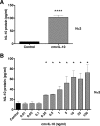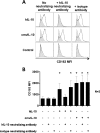Human Cytomegalovirus-Encoded Human Interleukin-10 (IL-10) Homolog Amplifies Its Immunomodulatory Potential by Upregulating Human IL-10 in Monocytes
- PMID: 26792743
- PMCID: PMC4810557
- DOI: 10.1128/JVI.03066-15
Human Cytomegalovirus-Encoded Human Interleukin-10 (IL-10) Homolog Amplifies Its Immunomodulatory Potential by Upregulating Human IL-10 in Monocytes
Abstract
The human cytomegalovirus (HCMV) gene UL111A encodes cytomegalovirus-encoded human interleukin-10 (cmvIL-10), a homolog of the potent immunomodulatory cytokine human interleukin 10 (hIL-10). This viral homolog exhibits a range of immunomodulatory functions, including suppression of proinflammatory cytokine production and dendritic cell (DC) maturation, as well as inhibition of major histocompatibility complex (MHC) class I and class II. Here, we present data showing that cmvIL-10 upregulates hIL-10, and we identify CD14(+)monocytes and monocyte-derived macrophages and DCs as major sources of hIL-10 secretion in response to cmvIL-10. Monocyte activation was not a prerequisite for cmvIL-10-mediated upregulation of hIL-10, which was dose dependent and controlled at the transcriptional level. Furthermore, cmvIL-10 upregulated expression of tumor progression locus 2 (TPL2), which is a regulator of the positive hIL-10 feedback loop, whereas expression of a negative regulator of the hIL-10 feedback loop, dual-specificity phosphatase 1 (DUSP1), remained unchanged. Engagement of the hIL-10 receptor (hIL-10R) by cmvIL-10 led to upregulation of heme oxygenase 1 (HO-1), an enzyme linked with suppression of inflammatory responses, and this upregulation was required for cmvIL-10-mediated upregulation of hIL-10. We also demonstrate an important role for both phosphatidylinositol 3-kinase (PI3K) and STAT3 in the upregulation of HO-1 and hIL-10 by cmvIL-10. In addition to upregulating hIL-10, cmvIL-10 could exert a direct immunomodulatory function, as demonstrated by its capacity to upregulate expression of cell surface CD163 when hIL-10 was neutralized. This study identifies a mechanistic basis for cmvIL-10 function, including the capacity of this viral cytokine to potentially amplify its immunosuppressive impact by upregulating hIL-10 expression.
Importance: Human cytomegalovirus (HCMV) is a large, double-stranded DNA virus that causes significant human disease, particularly in the congenital setting and in solid-organ and hematopoietic stem cell transplant patients. A prominent feature of HCMV is the wide range of viral gene products that it encodes which function to modulate host defenses. One of these is cmvIL-10, which is a homolog of the potent immunomodulatory cytokine human interleukin 10 (hIL-10). In this study, we report that, in addition to exerting a direct biological impact, cmvIL-10 upregulates the expression of hIL-10 by primary blood-derived monocytes and that it does so by modulating existing cellular pathways. This capacity of cmvIL-10 to upregulate hIL-10 represents a mechanism by which HCMV may amplify its immunomodulatory impact during infection.
Copyright © 2016, American Society for Microbiology. All Rights Reserved.
Figures





Similar articles
-
Human Cytomegalovirus UL111A and US27 Gene Products Enhance the CXCL12/CXCR4 Signaling Axis via Distinct Mechanisms.J Virol. 2018 Feb 12;92(5):e01981-17. doi: 10.1128/JVI.01981-17. Print 2018 Mar 1. J Virol. 2018. PMID: 29237840 Free PMC article.
-
Human cytomegalovirus interleukin-10 polarizes monocytes toward a deactivated M2c phenotype to repress host immune responses.J Virol. 2013 Sep;87(18):10273-82. doi: 10.1128/JVI.00912-13. Epub 2013 Jul 17. J Virol. 2013. PMID: 23864618 Free PMC article.
-
Immunomodulatory properties of a viral homolog of human interleukin-10 expressed by human cytomegalovirus during the latent phase of infection.J Virol. 2008 Apr;82(7):3736-50. doi: 10.1128/JVI.02173-07. Epub 2008 Jan 23. J Virol. 2008. PMID: 18216121 Free PMC article.
-
Human Cytomegalovirus Interleukin 10 Homologs: Facing the Immune System.Front Cell Infect Microbiol. 2020 Jun 9;10:245. doi: 10.3389/fcimb.2020.00245. eCollection 2020. Front Cell Infect Microbiol. 2020. PMID: 32582563 Free PMC article. Review.
-
HCMV Infection and Apoptosis: How Do Monocytes Survive HCMV Infection?Viruses. 2018 Sep 29;10(10):533. doi: 10.3390/v10100533. Viruses. 2018. PMID: 30274264 Free PMC article. Review.
Cited by
-
Vaccine Vectors Harnessing the Power of Cytomegaloviruses.Vaccines (Basel). 2019 Oct 17;7(4):152. doi: 10.3390/vaccines7040152. Vaccines (Basel). 2019. PMID: 31627457 Free PMC article. Review.
-
New extracellular factors in glioblastoma multiforme development: neurotensin, growth differentiation factor-15, sphingosine-1-phosphate and cytomegalovirus infection.Oncotarget. 2018 Jan 9;9(6):7219-7270. doi: 10.18632/oncotarget.24102. eCollection 2018 Jan 23. Oncotarget. 2018. PMID: 29467963 Free PMC article. Review.
-
Reactivation of Cytomegalovirus Increases Nitric Oxide and IL-10 Levels in Sepsis and is Associated with Changes in Renal Parameters and Worse Clinical Outcome.Sci Rep. 2019 Jun 21;9(1):9016. doi: 10.1038/s41598-019-45390-x. Sci Rep. 2019. PMID: 31227794 Free PMC article.
-
Herpesviral capture of immunomodulatory host genes.Virus Genes. 2017 Dec;53(6):762-773. doi: 10.1007/s11262-017-1460-0. Epub 2017 Apr 27. Virus Genes. 2017. PMID: 28451945 Review.
-
Human Cytomegalovirus Infection and Breast Cancer: A Literature Review of Clinical and Experimental Data.Biology (Basel). 2025 Feb 8;14(2):174. doi: 10.3390/biology14020174. Biology (Basel). 2025. PMID: 40001942 Free PMC article. Review.
References
-
- Mocarski ES, Shenk T, Griffiths PD, Pass RF. 2013. Cytomegaloviruses, p 1960–2014. In Knipe DM, Howley PM, Cohen JI, Griffin DE, Lamb RA, Martin MA, Rancaniello VR, Roizman B (ed), Fields virology, 6th ed, vol 2 Lippincott Williams & Wilkins, Philadelphia, PA.
Publication types
MeSH terms
Substances
Grants and funding
LinkOut - more resources
Full Text Sources
Other Literature Sources
Research Materials
Miscellaneous

